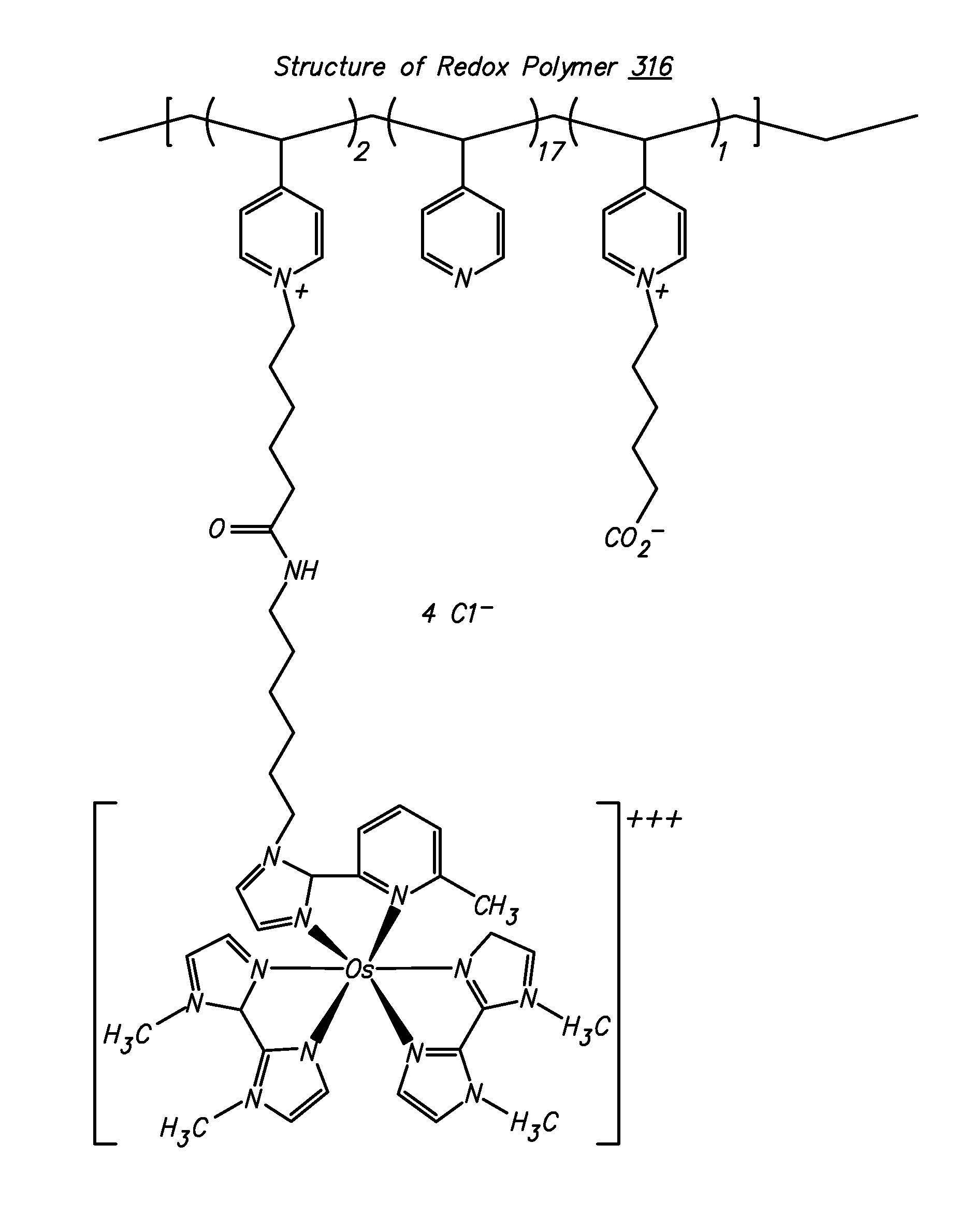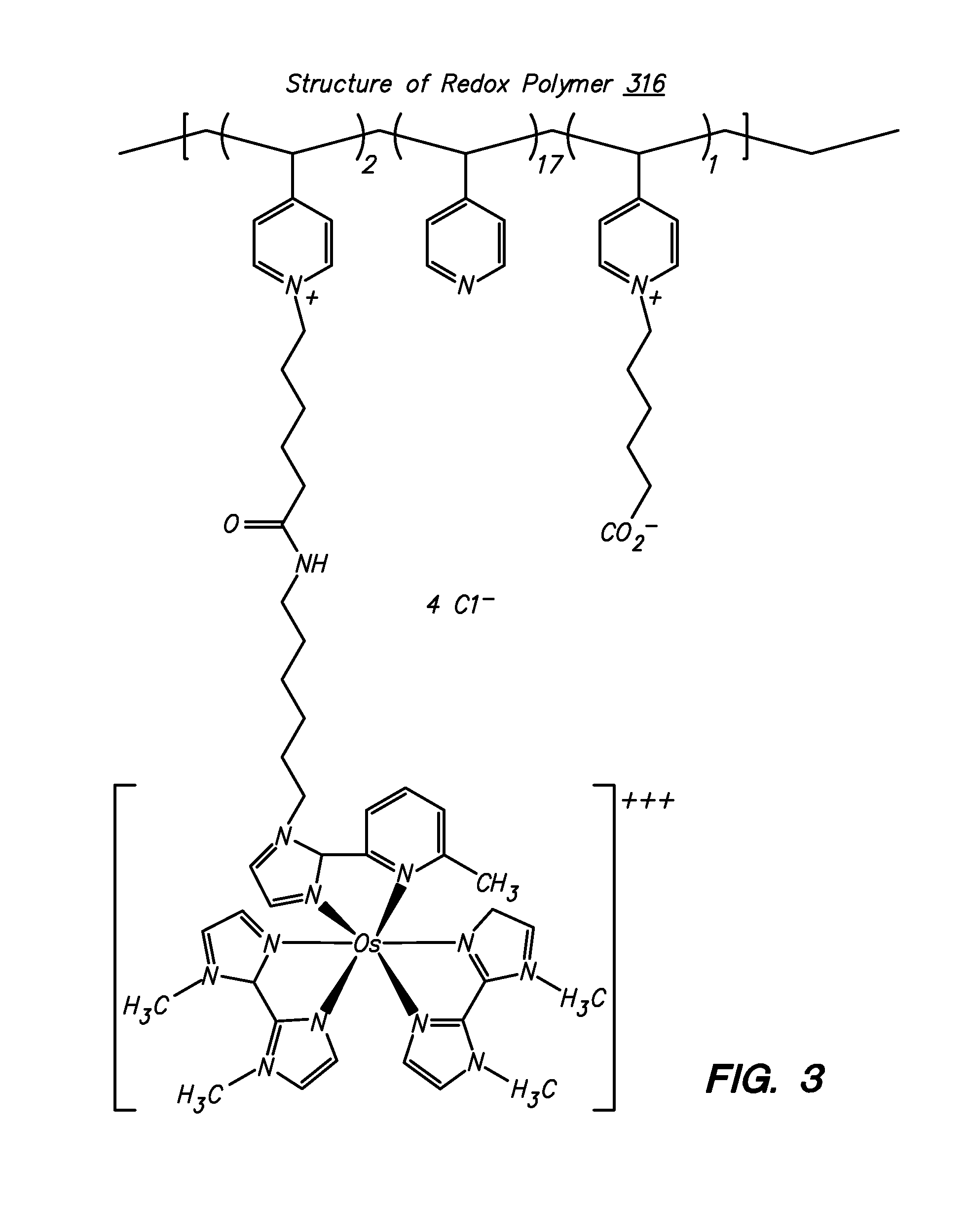Redox polymers for use in analyte monitoring
a technology of redox polymers and analyte monitoring, which is applied in the field of redox polymers for use in analyte monitoring, can solve the problems of low solubility of redox mediators in test solutions, poor chemical, light, thermal, or ph stability, and insufficient electron exchange with enzymes or electrodes
- Summary
- Abstract
- Description
- Claims
- Application Information
AI Technical Summary
Benefits of technology
Problems solved by technology
Method used
Image
Examples
example 1
Synthesis of 4-(5-carboxypentyl)amino-2,2′-bipyridyl
[0161]This example illustrates how a carboxy reactive group is introduced onto a 2.2′-bipyridyl derivative.
[0162]Synthesis of Compound D:
[0163]To compound C (formed from A and B according to
[0164]
Wenkert, D.; Woodward, R. B. J. Org. chem. 48, 283 (1983)) (5 g) dissolved in 30 mL acetic acid in a 100 ml round bottom flask was added 16 mL acetyl bromide. The yellow mixture was refluxed for 1.5 h and then rotovaporated to dryness. The resulting light yellow solid of D was sufficiently pure enough for the next step without further purification. Yield: 95%
[0165]Synthesis of Compound E:
[0166]To a stirred suspension of compound D in 60 mL CHCl3 was added 12 mL PCl3 at room temperature. The mixture was refluxed for 2 h under N2 and then cooled to room temperature. The reaction mixture was poured into 100 mL ice / water. The aqueous layer was separated and saved. The CHCl3 layer was extracted three times with H2O (3×60 mL) and then discarded....
example 2
Synthesis of a 4-((6-Aminohexyl)amino)-2,2′-bipyridine
[0171]
[0172]This example illustrates the general synthesis of a 2,2′-bipyridyl with an amine reactive group.
[0173]Synthesis of Compound H:
[0174]A mixture of compound E (2.5 g) and 1,6-diaminohexane (15 g) in a 250 mL round bottom flask was heated under N2 at 140° C. in an oil bath for 4-5 h. Excess 1,6-diaminohexane was removed by high vacuum distillation at 90-120° C. The product was purified by a silica gel column, eluting with 5% NH4OH in isopropyl alcohol. Yield: 70%.
example 3
Synthesis of 1,1′-dimethyl-2,2′-biimidazole
[0175]This example illustrates the synthesis of 2,2′-biimidazole derivatives.
[0176]
[0177]The alkylation step can be carried out stepwise so two different alkyl groups can be introduced. For example:
[0178]
[0179]Synthesis of Compound K:
[0180]To a stirred solution of compound J (formed from I according to Fieselmann, B. F., et al. Inorg. Chem. 17, 2078 (1978)) (4.6 g, 34.3 mmoles) in 100 mL dry DMF in a 250 ml round bottom flask cooled in an ice / water bath was added in portions NaH(60% in mineral oil, 2.7 g, 68.6 mmoles). After the solution was stirred at 0° C. for one more hour under N2, methyl toluenesulfonate (10.3 mL, 68.6 mmoles) was added in small portions using a syringe over 30 min. The stiffing of the solution in the ice / water bath was continued for 1 h and then at room temperature for 3 h. The solvent was removed by vacuum distillation. The dark residue was triturated with ether and then suction filtered and dried under vacuum. The p...
PUM
| Property | Measurement | Unit |
|---|---|---|
| thick | aaaaa | aaaaa |
| electrode potentials | aaaaa | aaaaa |
| pH | aaaaa | aaaaa |
Abstract
Description
Claims
Application Information
 Login to View More
Login to View More - R&D
- Intellectual Property
- Life Sciences
- Materials
- Tech Scout
- Unparalleled Data Quality
- Higher Quality Content
- 60% Fewer Hallucinations
Browse by: Latest US Patents, China's latest patents, Technical Efficacy Thesaurus, Application Domain, Technology Topic, Popular Technical Reports.
© 2025 PatSnap. All rights reserved.Legal|Privacy policy|Modern Slavery Act Transparency Statement|Sitemap|About US| Contact US: help@patsnap.com



